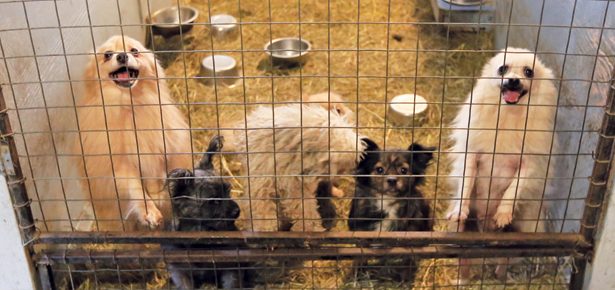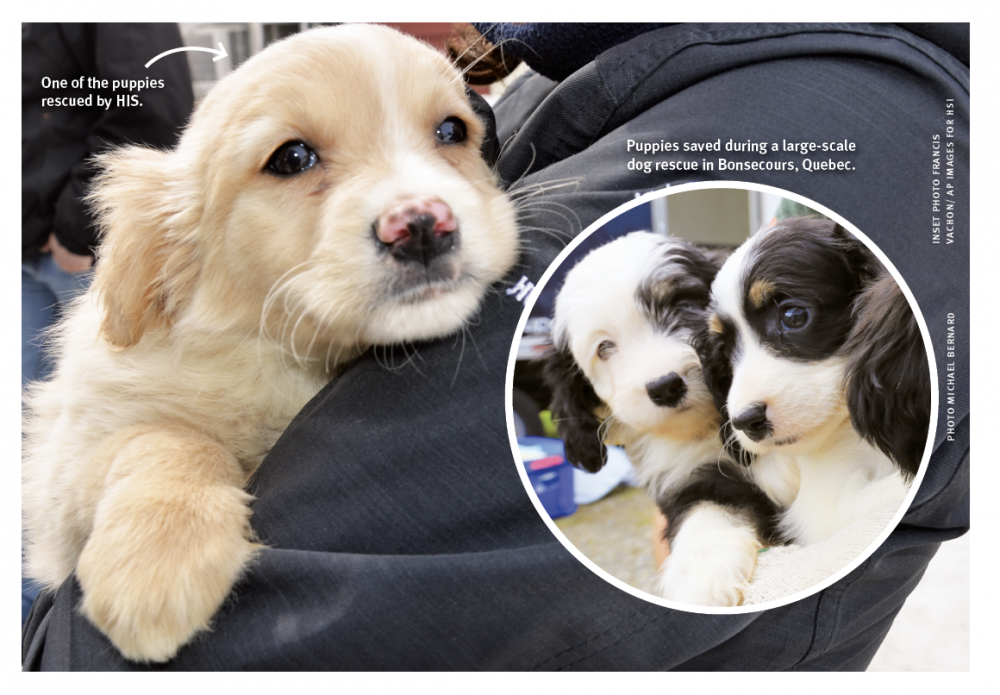

Before Your Dog Was Rescued
Here's what happens between rescue and adoption
The unsung heroes that rehabilitate dogs rescued from egregious abuse—think puppy mill seizures and hoarding cases—play a vital, if oftentimes unrecognized, role in saving animals desperately in need of a second chance and hereto unknown human kindness.
Alot happens in between a rescue operation and adoption, but sheltering doesn’t always get the recognition it deserves. It’s a long road to recovery for abused and neglected animals, with volunteers working hard behind-the-scenes to give deserving dogs and cats (and roosters?) a second chance at a happy life.
Blink and you missed it—an asphalt lot, two non-descript warehouses, and a whole lot of emptiness. Trucks and local commuter traffic whiz by along a rural road, the drivers clueless to the fact they’re within barking distance of an emergency animal shelter. What they don’t know is that it’s kept secret for a reason.
Inside, hundreds of dogs and cats and even a few roosters are in various stages of recuperation, having been seized from terrible situations. These survivors—emaciated, parasite ridden, malnourished, scared, and battling infection—have been removed from hoarding or abusive situations. They begin their road to recovery at this facility, where selfless volunteers spend their days cleaning cages, scrubbing floors, and making life more bearable for their furry wards while the legal system decides custody.
Take Maggy, for instance—rescuers found this sweet, blond Pomeranian crammed into a tiny cage filled with other dogs inside a densely-packed puppy mill. Born a prisoner, she never received the care and attention she so desperately needed. When Maggy was finally liberated from her cage, veterinary technicians discovered she was suffering from a very large and very painful bleeding tumor on her abdomen. Thankfully, she received immediate attention, followed by weeks of individual care, and today she lives a happy, healthy life with her adoptive family.
From puppy mill to forever home: how it works
Animal welfare laws and rescue protocol vary from state-to-state and province-to-province. Typically, an animal welfare organization is only allowed to carry out inspections and seizures if some level of government mandates them to do so. A rescue occurs following inspections that prove the animals on the premise are not being adequately cared for according to law. It is usually only the most egregious cases of abuse or neglect that result in a seizure. These are the animals that end up in an interim facility as described above.
Once the animals are rescued and removed from the property, they are transported to a shelter or emergency facility where they are housed and cared for until a judge has ruled on the case. This process can take weeks, months, sometimes even up to a year—which places tremendous strain on the people responsible for providing care.
Humane Society International/Canada, a non-profit animal welfare organization, knows these pressures all too well. Based in Montreal, they work with the Quebec government and assist in rescue operations. They also have the sole responsibility of managing the emergency shelter, the location of which is kept a secret for security reasons. And because the running and operation of the shelter is almost entirely dependent upon fundraising, money is always in short supply and volunteers are worth their weight in gold.
A passion for helping animals in need
It was September 2011 when volunteer Jennifer Rose got the call to assist HSI/Canada in what would later be confirmed as the largest puppy mill seizure in Canadian history. “It was a life-changing experience to see 570 dogs arrive at the shelter, truckload after truckload at all hours of the night,” she recounted.
Though the dogs ended up being at the shelter for three months, Jennifer continued to show up to volunteer; she had caught the volunteer bug, she said, after one of her first foster experiences, a puppy mill dog who was “terrified of everything when she arrived, and it broke my heart. When I read about the volunteers who helped get her out of that horrible place I knew I needed to find out how I could do that too. It’s been my mission ever since.”
The transformation of the rescued dogs is nothing short of miraculous. “I have seen animals come in that are terrified, anxious, thin, ill…and I get to see their personalities slowly emerge over time. I love when we get to take the dogs outside—many of them have never seen grass, or even been outside. At first they’re scared but then they start to relax enough to enjoy the feel of the sun and smell of the grass—it’s truly amazing! These milestones make my heart swell and I could not love them more.”
The toughest job you’ll ever love
To be clear, rehabilitating rescue dogs is much more than tummy rubs and playing fetch. Team leaders arrive at the emergency shelter at around 7:45 am and are letting dogs out for their morning walk by 8 am. When the dogs are outside, a volunteer will clean the cage and replace the cardboard that lines the floor. Depending on the dog and the state of his or her digestive tract, some enclosures can end up being more work to clean than others. You get the gist.
Once everyone is walked and had their cages cleaned, it’s feeding time. After some grub, the barking subsides and volunteers get busy mopping the floor and taking out the trash. A donated washer and dryer rumble along as a never-ending rotation of flannel doggie blankets and mop heads are cleaned for the umpteenth time. By the time noon rolls around you’ve already put in one helluva day… and it’s only half over. Then it’s more walking, more cage-cleaning, another meal, a good sweep and mop, then if there’s time, enrichment—that’s special one-on-one time where dogs get individual love and attention. One team leader even massages the dogs (when that leg starts going you know you hit the magic spot!).
Everyone has their own take on enrichment, and classic rock fans will no doubt delight in Jennifer’s unique brand of canine therapy. “There was a Husky who would try to make herself as small as she could at the back of her run because she was so overwhelmed and afraid. One day I went into her run with her and just sat on the floor, not looking at her. I started to sing to her, and the first thing that came to mind was “Stairway to Heaven.” As I was singing I felt her get up and slowly approach me. She started to gently sniff my hair and clothes while I kept singing. From that moment on she would come to me to take treats or let me put a leash on her to take her out for some fresh air. We had a special bond.”
So special, in fact, that she gave her new friend a special name—something to always remind Jennifer why she kept going back to help, day after day. “I named her Zeppelin.”
Flash-forward four years and Jennifer is at the airport awaiting a flight to go train other volunteers. She chokes up at the memory of some of the first dogs she helped. It dawns on her how far she’s come, and she says she feels privileged to be passing on her knowledge to others wishing to make a difference in the lives of animals who have, thus far, only known the worst of humanity.
“I tell people when I do these training sessions that it honestly changed my life. I’ve met the most incredible people, the most incredible animals; I’ve seen dogs go from having no life in their eyes to the beginning of a twinkle, a spark of hope… it’s opened up a whole new world to me. Anything I can do—whether it’s training volunteers or helping at the shelter—I want to do to make a difference and, in the process, make our world a better place for animals.”
Join the newsletter and never miss out on dog content again!
"*" indicates required fields
By clicking the arrow, you agree to our web Terms of Use and Privacy & Cookie Policy. Easy unsubscribe links are provided in every email.
